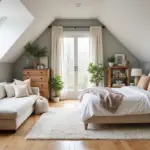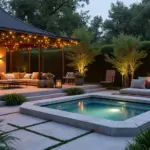Ready to transform your home décor? Layering rugs on top of carpet is a fantastic way to add texture, warmth, and style to any room.
Whether you’re after a cozy nook or a chic living space, the right combination can make your area pop while maintaining comfort.
Explore this curated list of 27 amazing ideas that not only look good but also fit seamlessly into modern interior design trends. Let’s get inspired!
1. Contrast Bold Colors
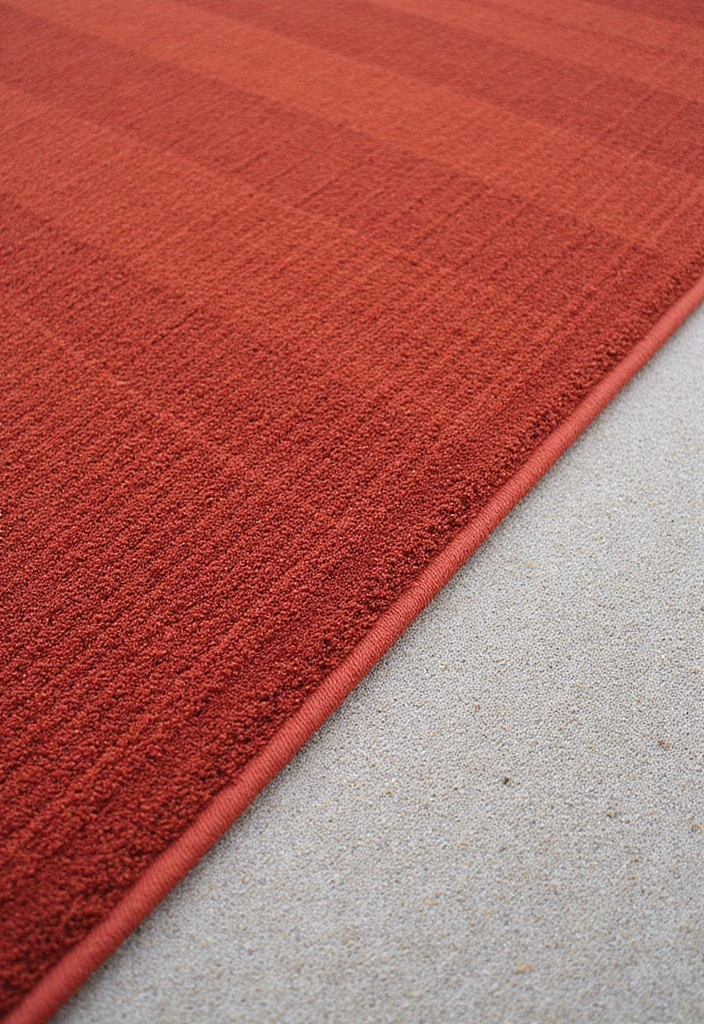
One effective way to create a striking visual impact is by layering rugs with contrasting colors on a neutral carpet.
For instance, a vibrant, deep blue Persian rug atop a light grey carpet can make your space feel alive. Adding pillows and throws that echo the rug’s hues will enhance the cohesive feel. Here’s how to pull it off:
– Choose a carpet color that offers a subtle backdrop.
– Select a rug that features bold patterns or rich colors.
– Balance bold with accessories that incorporate similar tones.
This approach not only draws the eye but also invites conversation.
Layering rugs on top of carpet is your ticket to a cozy, chic space! Embrace bold colors and patterns to transform your room into a vibrant sanctuary that tells your style story.
2. Natural Fiber Wonders
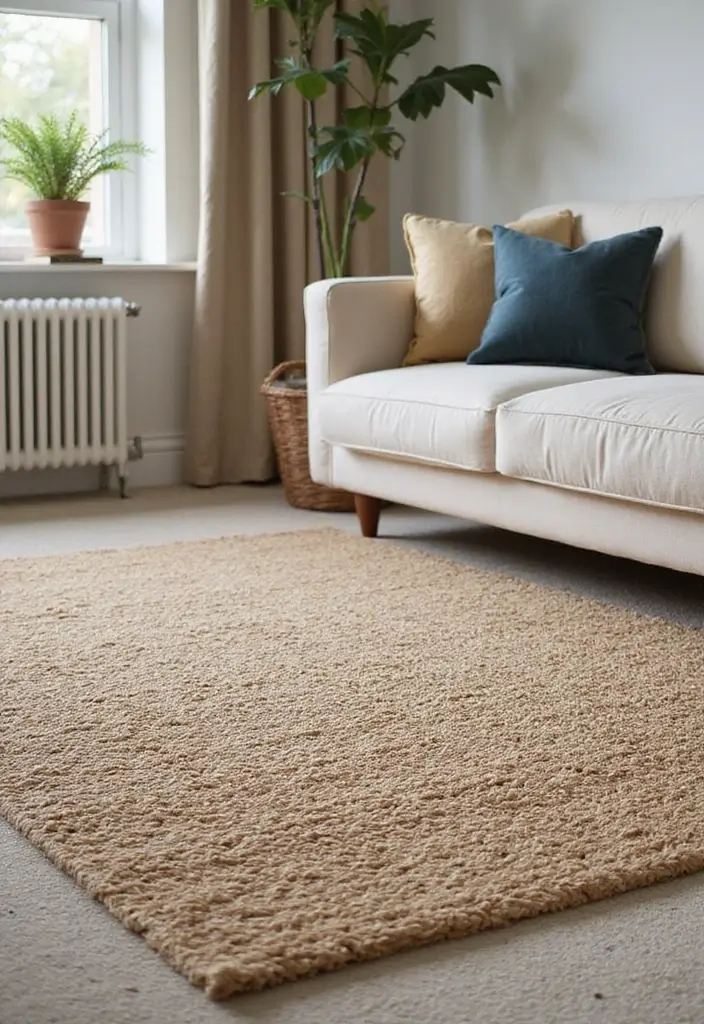
Rugs made from natural fibers such as jute or sisal can beautifully complement a plush carpet.
These earthy textures create a serene environment and are perfect for spaces aiming for a calm aesthetic. They also provide a stunning contrast in texture to soft carpets. Consider these tips:
– Place a jute rug in a high-traffic area for durability.
– Use neutral tones to maintain a light atmosphere.
– Layer rugs with varying fiber types for added intrigue.
This method works especially well in living rooms or dens.
3. Play with Patterns
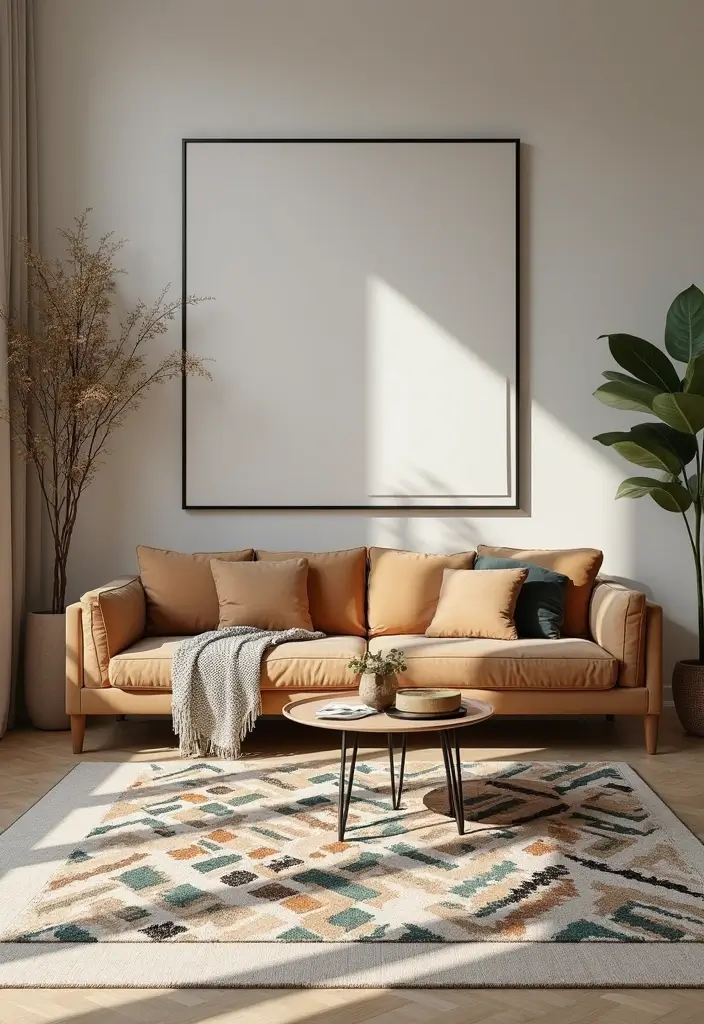
Mixing patterns can add depth and personality to your space. Layering a geometric rug over a simpler carpet allows for stylish contrast without overwhelming the senses.
Here’s how to master this look:
– Pair a patterned area rug with a solid-colored carpet.
– Ensure that the patterns complement each other in scale – larger patterns can work over smaller ones.
– Use throw pillows or art that incorporate similar motifs for cohesiveness.
This playful approach makes your space unique and stylish.
4. Create Zones
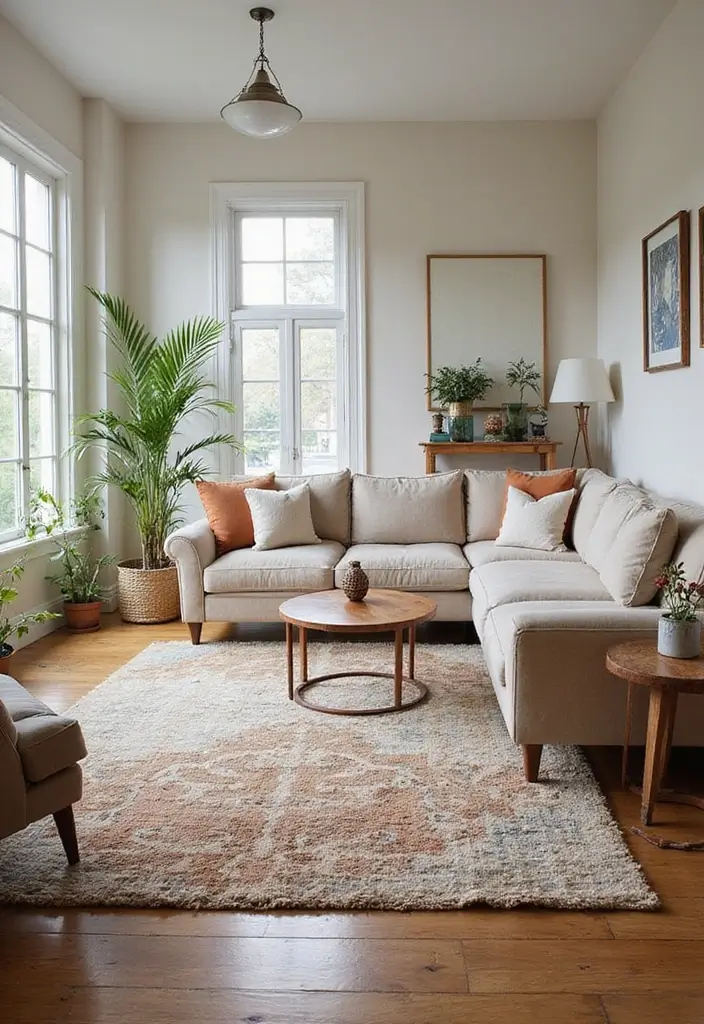
Layered rugs can help define different areas within a larger room, especially in open-concept spaces.
For example, placing a round rug under a coffee table on top of a carpet can create a cozy conversation nook. Here’s how to achieve this effectively:
– Use a larger carpet as your base layer to define the overall space.
– Choose smaller area rugs to create distinct zones for different activities, like reading or dining.
– Ensure each rug maintains a distinct but complementary style to your overall decor.
This layout not only enhances functionality but also adds variety to your interior.
5. Soft and Plush
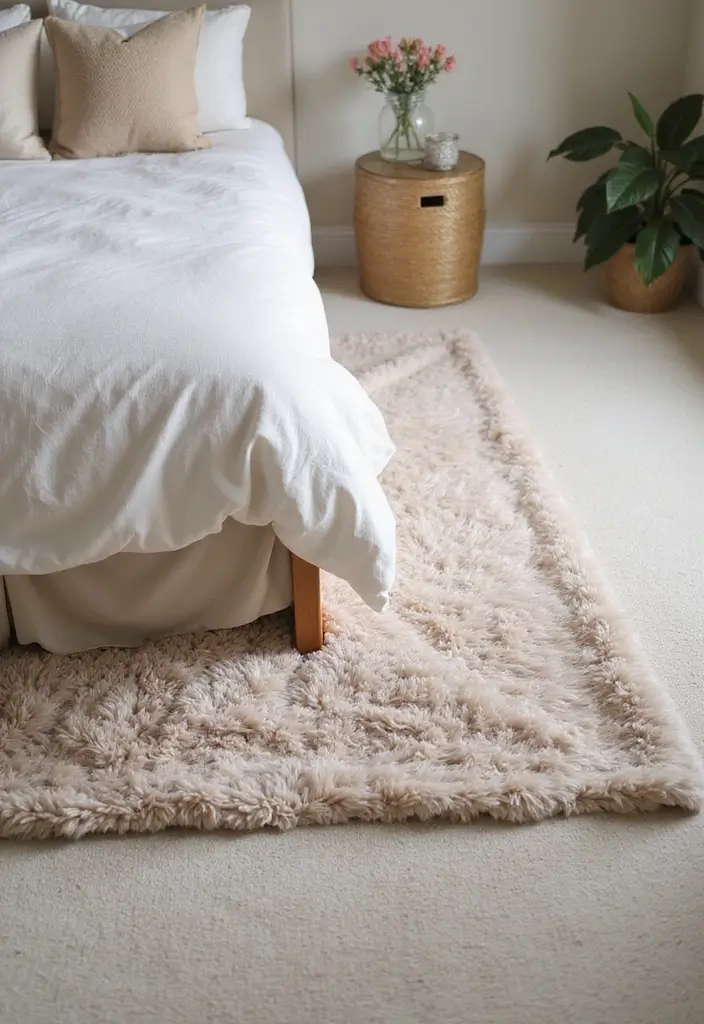
For maximum coziness, consider layering a soft, plush rug on top of a carpet. This combination is perfect for bedrooms or reading nooks where comfort is key.
Here are some great tips for this approach:
– Choose a shag or high-pile rug for the top layer to enhance softness.
– Keep the base carpet neutral to allow the top rug to stand out.
– Use muted colors for a calm, relaxing atmosphere or vibrant tones for a playful vibe.
This creates a sanctuary-like atmosphere, inviting relaxation.
6. Modern Minimalism
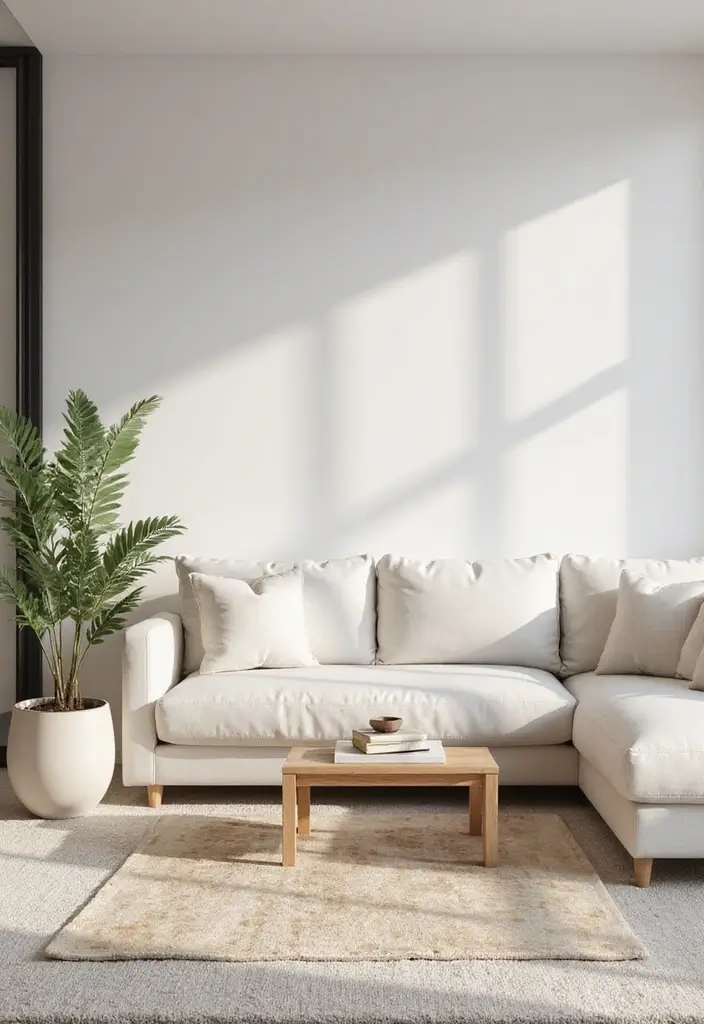
If you lean towards a minimalist aesthetic, a clean-line rug can look stunning on a simple carpet.
This approach emphasizes subtlety and sophistication, creating a serene environment. Here’s how to keep it minimal:
– Opt for a rug with minimalistic patterns or solid colors.
– Ensure the carpet acts as a neutral backdrop, allowing the rug to shine.
– Use furniture with sleek profiles to maintain the clean lines throughout.
This approach reflects contemporary design principles and keeps the space feeling open.
7. Vintage Charm
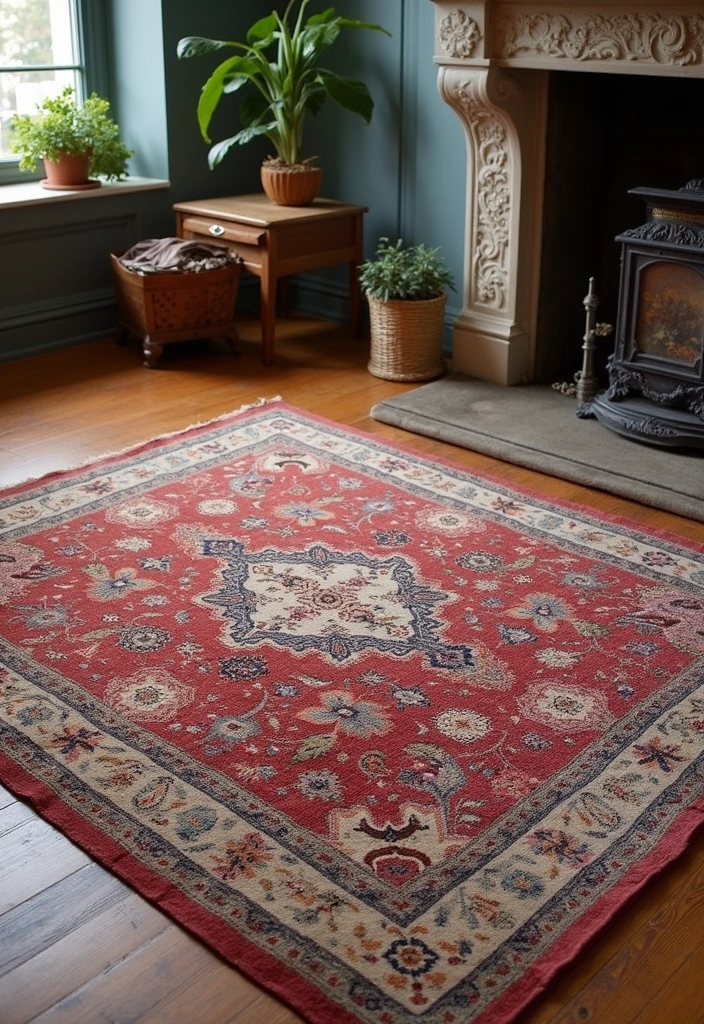
Incorporating vintage or antique rugs can add a rich layer of history to your carpeted space.
These rugs bring unique patterns and colors that can tie a room together beautifully. Here are some ways to style vintage pieces:
– Select a rug with a worn, distressed look that complements your carpet’s color.
– Pair with modern furnishings to create an eclectic balance.
– Don’t shy away from layering more than one vintage rug for depth!
This style not only enhances aesthetics but also adds a story to your décor.
8. Textured Tones
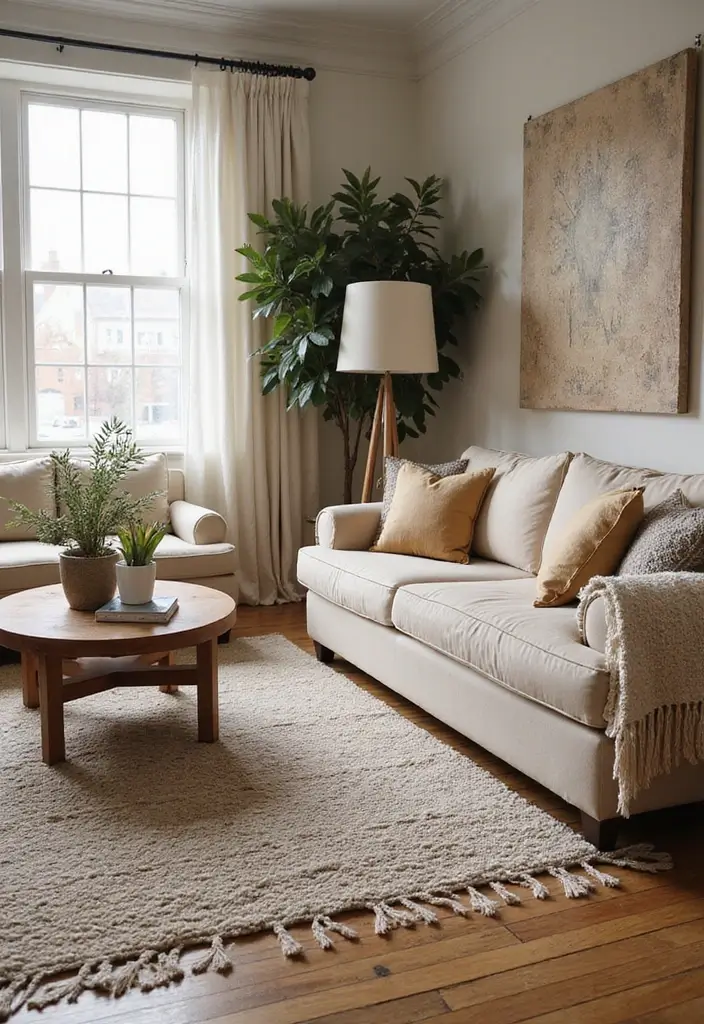
Experimenting with different textures is a fun way to elevate your interior. Layering a soft rug with a textured carpet adds intrigue and tactile appeal.
To master this look:
– Choose a rug that has a contrasting texture to your carpet, like a flatweave over a plush pile.
– Play with color tones that harmonize but differ in intensity for dimension.
– Consider adding decorative pillows that feature similar textures to tie everything together.
The result is a chic, layered look that feels welcoming.
9. Layering Under Furniture
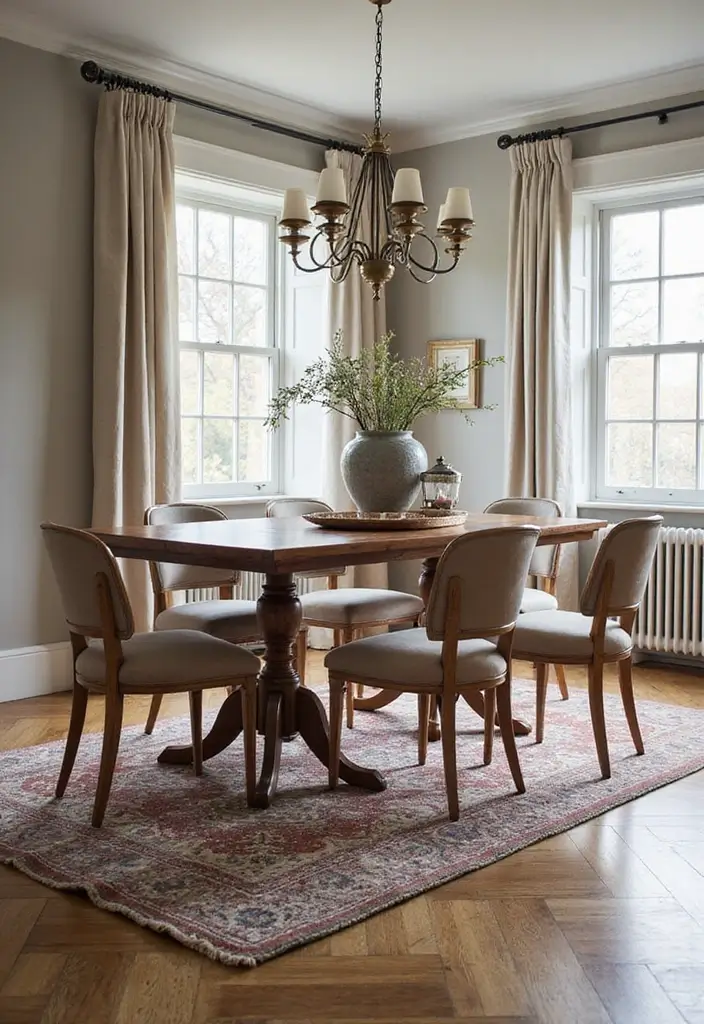
A clever technique to enhance your space is by layering rugs under key pieces of furniture.
This method creates a grounded feel while adding visual interest. Here’s how to do it:
– Use a large area rug as a base beneath a sofa or dining table.
– Layer a smaller rug on top, leaving space around it to showcase both pieces.
– Ensure the colors and patterns complement each other for seamless integration.
This approach can help your space feel more polished and intentional.
10. The Pop of Color
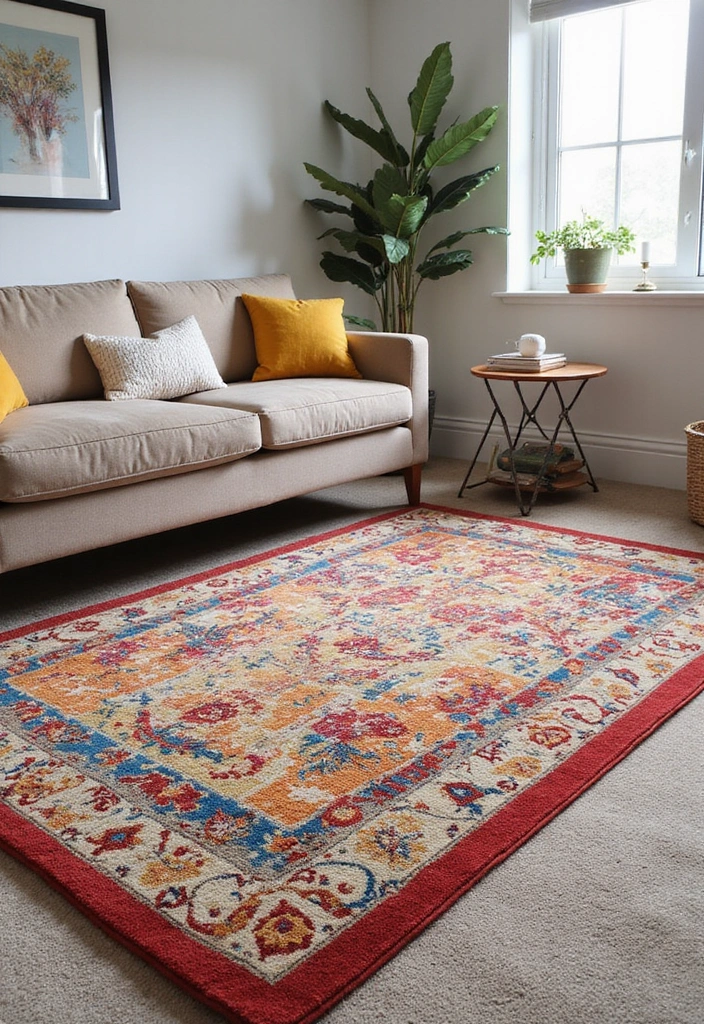
Injecting a pop of color into a neutral carpet with a bright rug can dramatically change the room’s mood.
A vivid area rug can serve as the centerpiece of your décor. Here are some ideas:
– Opt for a bold patterned rug that features colors found throughout the room.
– Position the rug in a high-visibility area to draw attention.
– Coordinate other elements, like artwork or cushions, to reflect the rug’s tones.
This can brighten your space and invigorate your home.
11. Layering for Sound Absorption
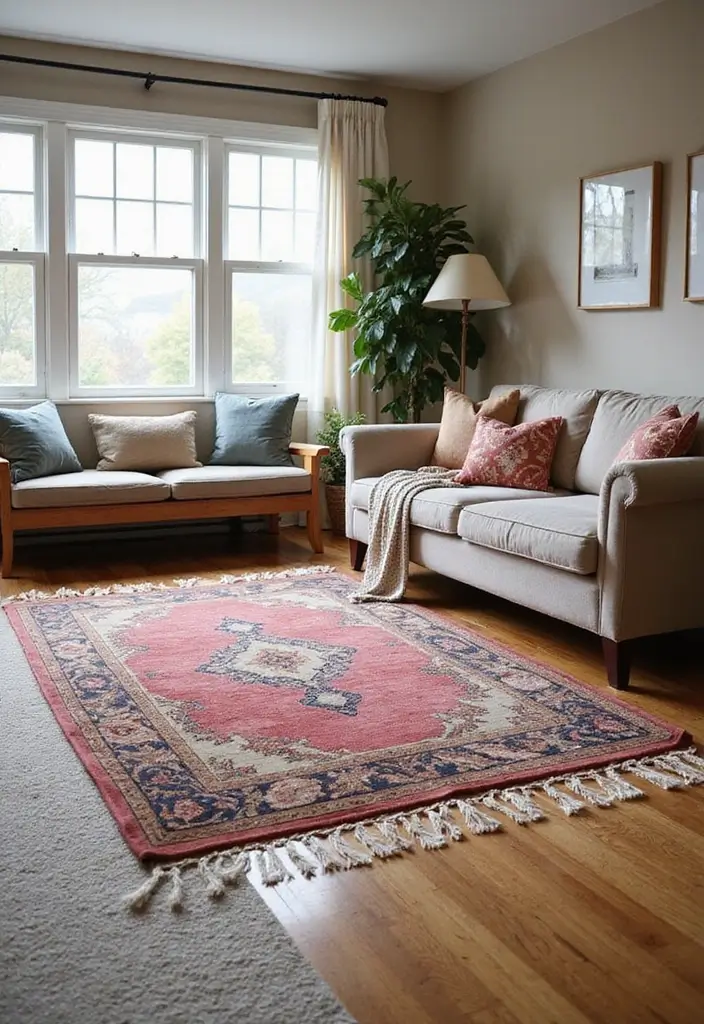
Layering rugs can also be a practical choice for sound absorption, especially in homes with hard floors.
Adding an area rug on carpet helps muffle noise while providing comfort. Key tips include:
– Choose thicker rugs for maximum sound absorption.
– Use rugs with varying textures to enhance the auditory experience.
– Strategically place rugs in areas with high foot traffic to reduce noise.
This approach marries functionality with style, creating a peaceful atmosphere.
12. Seasonal Changes
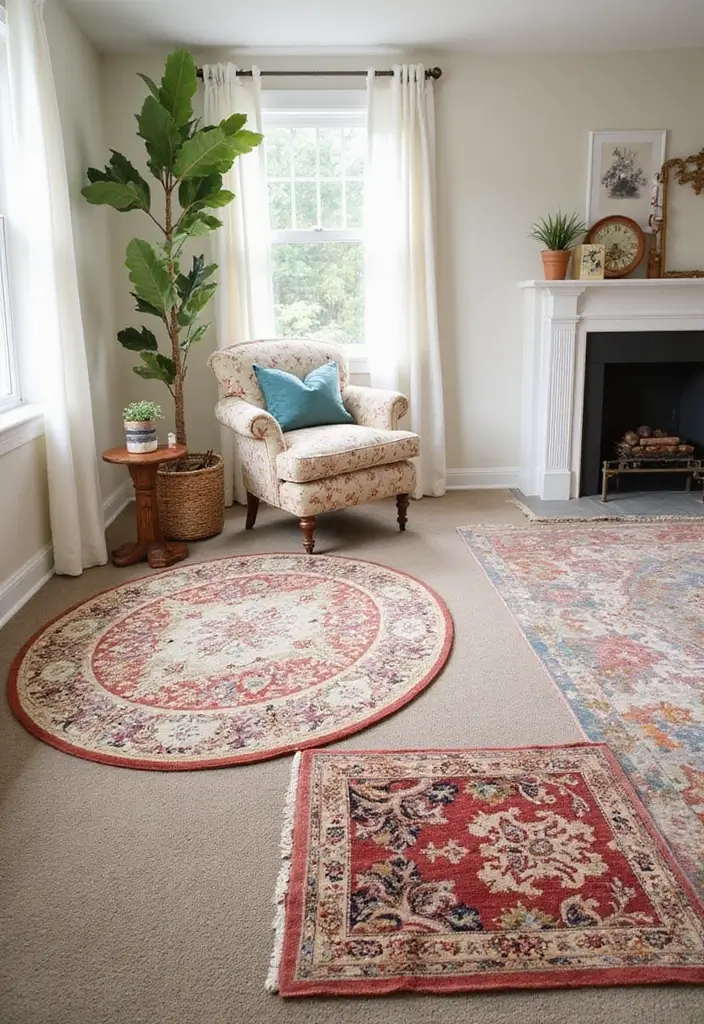
Switching out rugs seasonally can freshen up your décor. Layering a winter-themed rug over your carpet can bring warmth during chilly months, while a lighter rug can enhance summer vibes.
To keep it seasonal:
– Use heavier, plush rugs for winter and lighter, airy options for summer.
– Incorporate seasonal colors, like warm tones for fall and cool shades for spring.
– Don’t forget to switch up accessories like throws and pillows to match.
This keeps your home feeling dynamic and inviting throughout the year.
Switching out rugs on top of carpet seasonally brings fresh energy! Embrace cozy warmth with plush textures in winter and light, airy vibes in summer for a home that feels alive year-round.
13. Artistic Flair
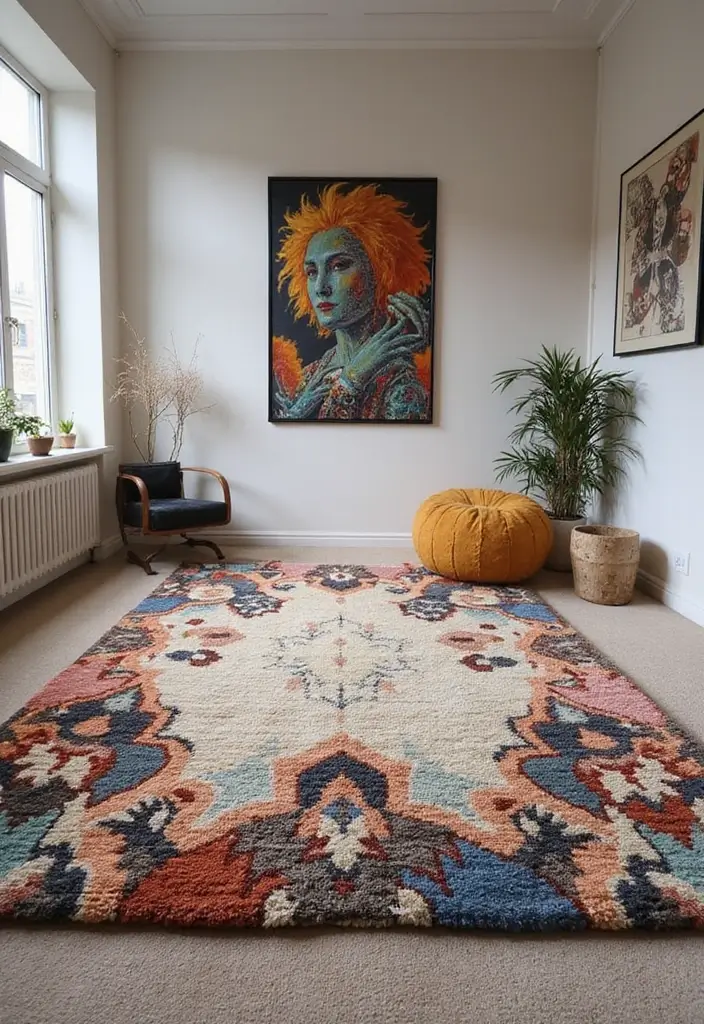
Using an artistically designed rug can serve as the art of your room. Layering it over a carpet allows for creative expression that captivates the eye. Consider these tips:
– Select rugs with bold art-like designs to act as focal points.
– Keep surrounding décor simple to let the rug shine.
– Use accent pieces that reflect colors or themes found in the rug.
This method transforms your living space into a curated gallery, blending art with comfort.
14. The Power of Texture Mixing
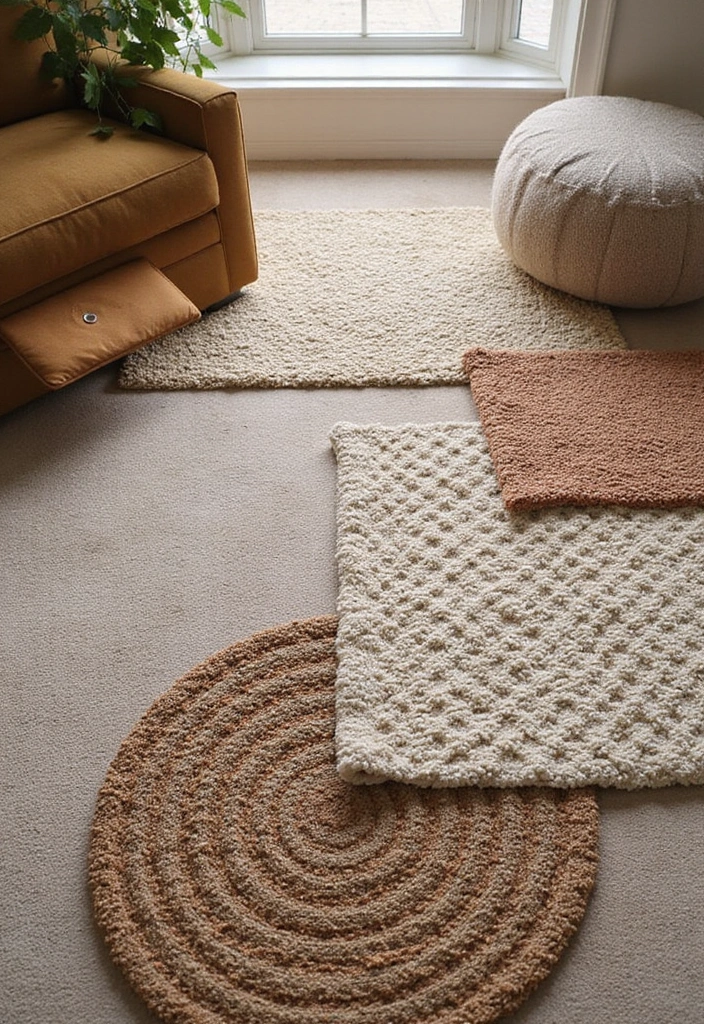
Combining textured rugs over carpet is a simple way to create visual intrigue. Mixing materials like wool with cotton or synthetic fibers can add depth to your space. Here’s how to get it right:
– Choose rugs made from different materials to emphasize texture contrast.
– Ensure that color palettes still match or complement.
– Use layering to create a cascade of textures that invite touch.
This approach not only looks stunning but also enriches the sensory experience of your home.
15. Layering with Purpose
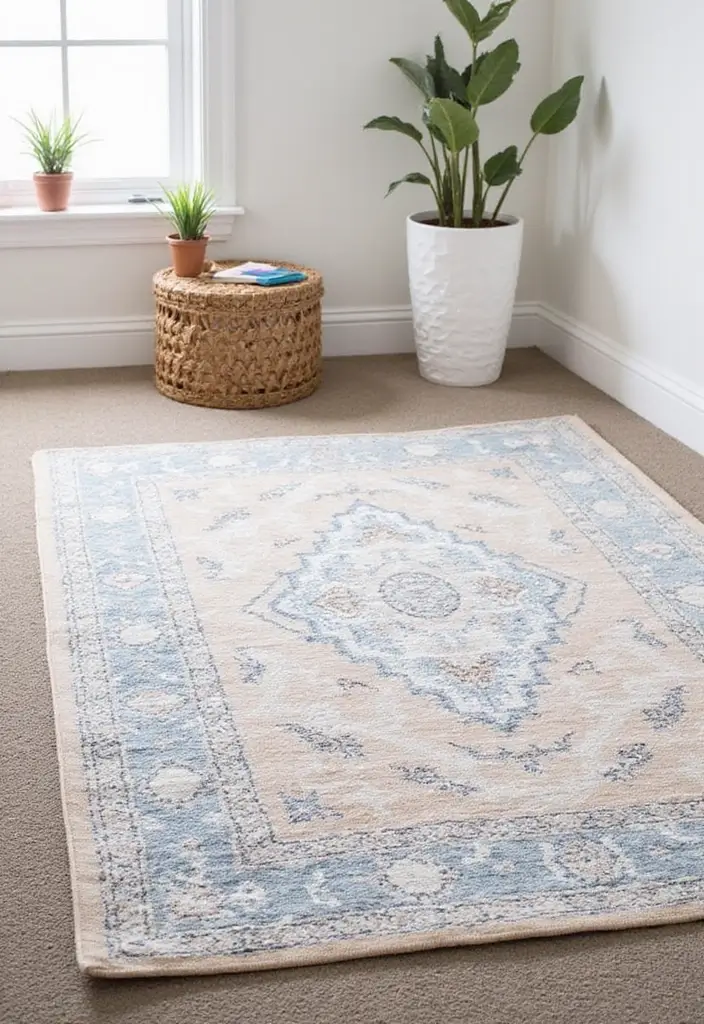
When layering rugs on carpet, think of purpose. Each layer can serve a distinct function that contributes to your overall design. Here’s how:
– Use a rug to define specific areas, like a reading nook or play area.
– Choose rugs based on durability for high-traffic spaces versus comfort for relaxation zones.
– Don’t be afraid to mix styles to showcase different moods in your home.
Layering with intention brings clarity and purpose to your design, enhancing the overall experience.
16. A Monochromatic Scheme
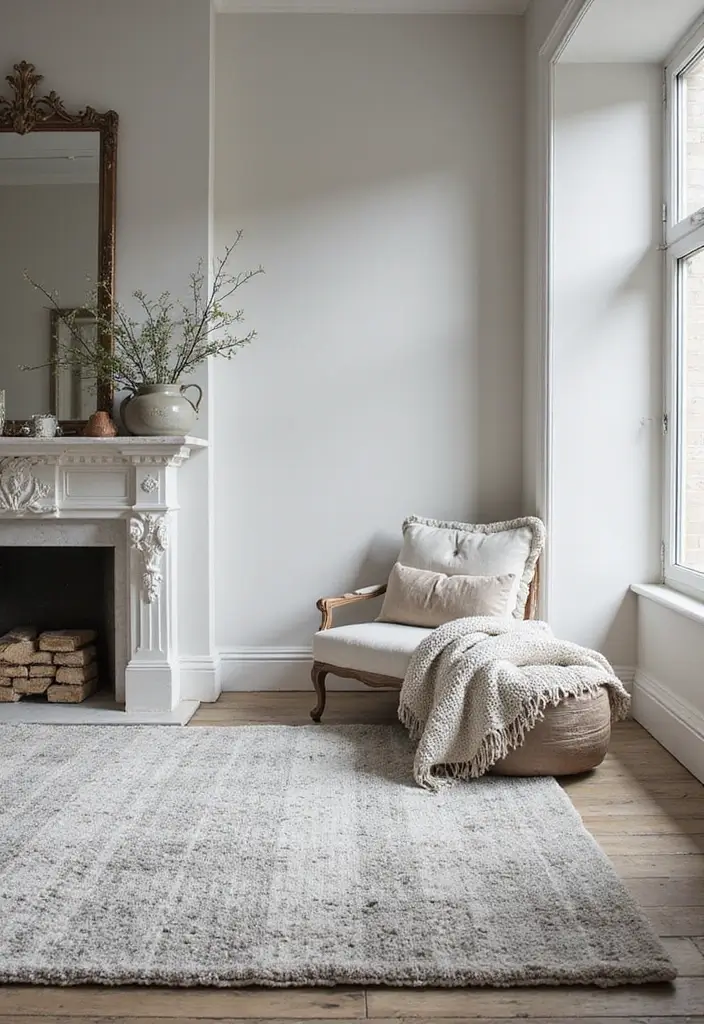
Opting for a monochromatic look can create a calm, organized ambiance. Layering rugs in similar shades on a matching carpet brings a sense of continuity to your space. Here are some ways to master this look:
– Choose rugs with varied textures but in the same color family.
– Use lighter shades on a darker carpet or vice versa for visual contrast.
– Incorporate accents like plants or art in the same monochromatic palette for added depth.
This creates a sophisticated, visually cohesive environment that feels unified.
17. You Can Never Have Enough Layers
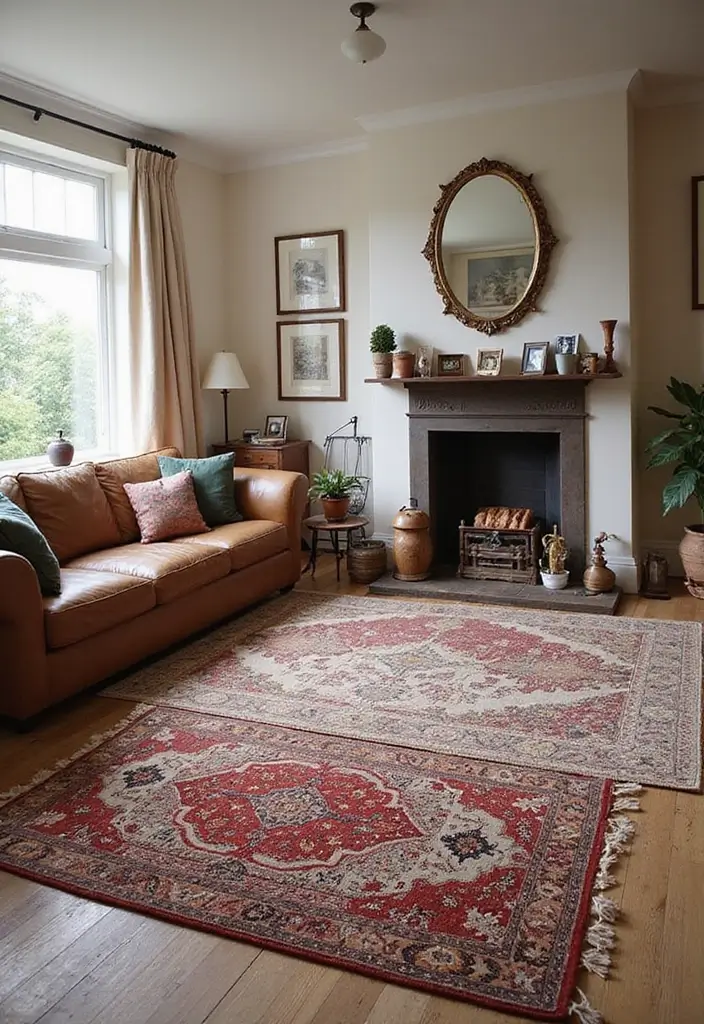
Don’t shy away from layering multiple rugs on carpet; it adds depth and visual interest.
For example, using three rugs of varying sizes and patterns can create an eclectic vibe. Here are some tips to pull this off:
– Start with a large base rug, then layer two smaller ones on top.
– Ensure that the rugs have a unifying element—color, pattern, or texture—to avoid chaos.
– Vary the shapes (round, square, rectangular) for added fun.
This approach creates an inviting, cozy atmosphere perfect for creative expression.
18. Bohemian Mix
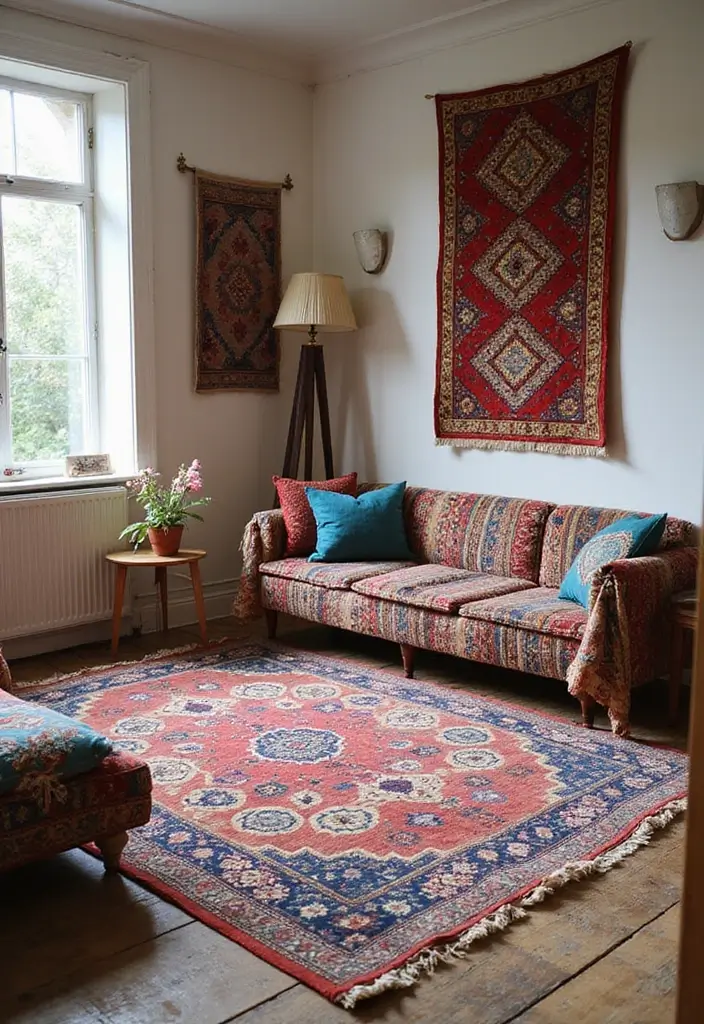
A bohemian aesthetic can be beautifully achieved with layered rugs. Using a variety of patterns and textures can create a free-spirited atmosphere. Here are some tips:
– Choose eclectic rugs with vibrant colors and patterns.
– Layer them over a simple carpet to avoid overwhelming the space.
– Incorporate natural elements like plants and wooden accents for authenticity.
This style fosters a warm, inviting space that feels lived in and embraced.
19. Outdoor-Inspired Decor
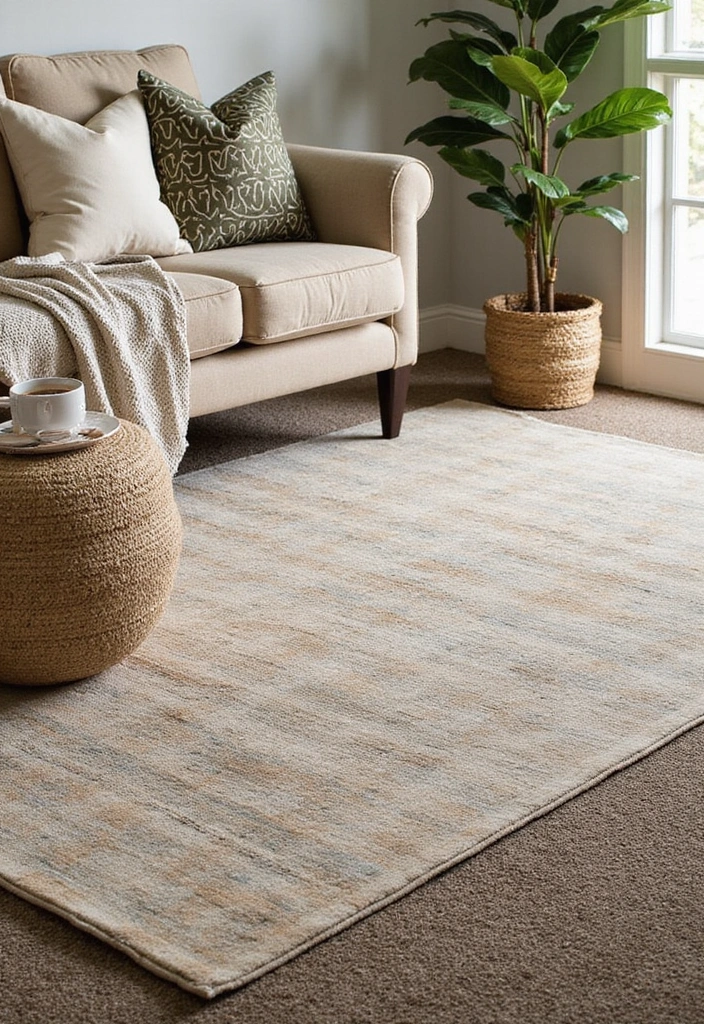
Bring the outdoors in by layering outdoor rugs on indoor carpets. This style promotes natural materials and earthy tones. Consider the following:
– Choose weather-resistant rugs that can manage indoor traffic.
– Pair them with a soft carpet for contrasting textures.
– Use botanical décor to enhance the nature-inspired theme.
This approach creates a refreshing, organic vibe that connects your indoor spaces with the natural world.
20. Layering with Luxury
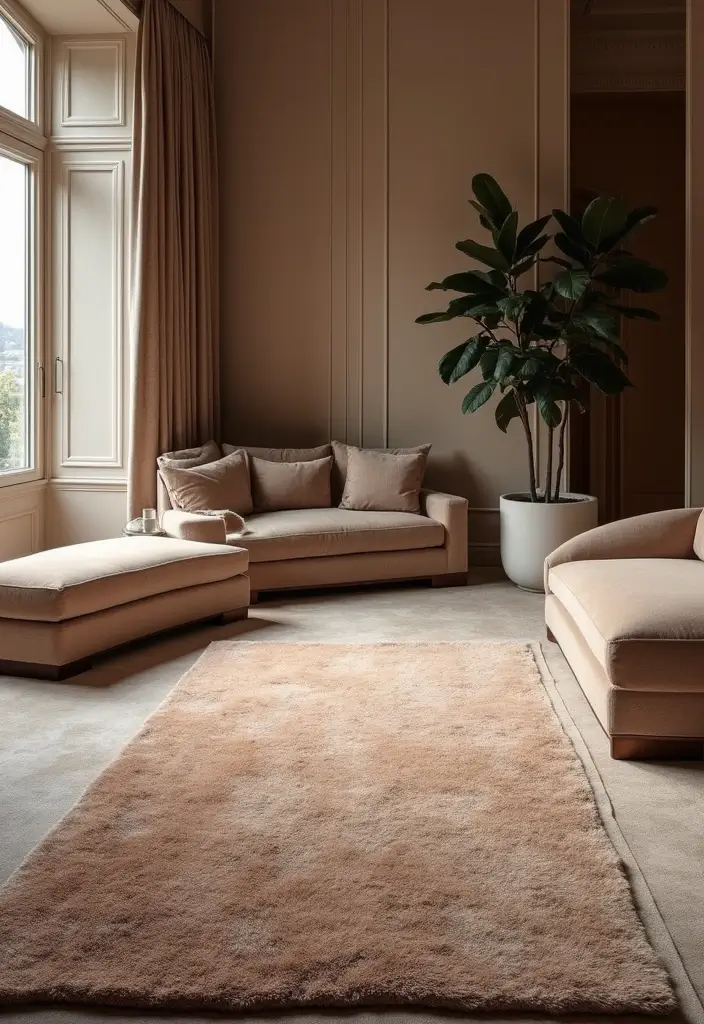
For a high-end look, consider layering luxurious rugs over plush carpets. This technique speaks to sophistication and style. Tips for achieving luxury include:
– Choose rich fabrics like silk or velvet for the top rug.
– Use subtle patterns that complement the carpet’s tone.
– Incorporate other luxurious materials, like leather or metallic accents.
This style creates an elegant environment that exudes comfort and opulence.
Layering luxurious rugs on top of carpet isn’t just decor; it’s an invitation to luxury. Embrace richness in textures and watch your space transform into a haven of elegance and comfort!
21. Layering for Child-Friendly Spaces
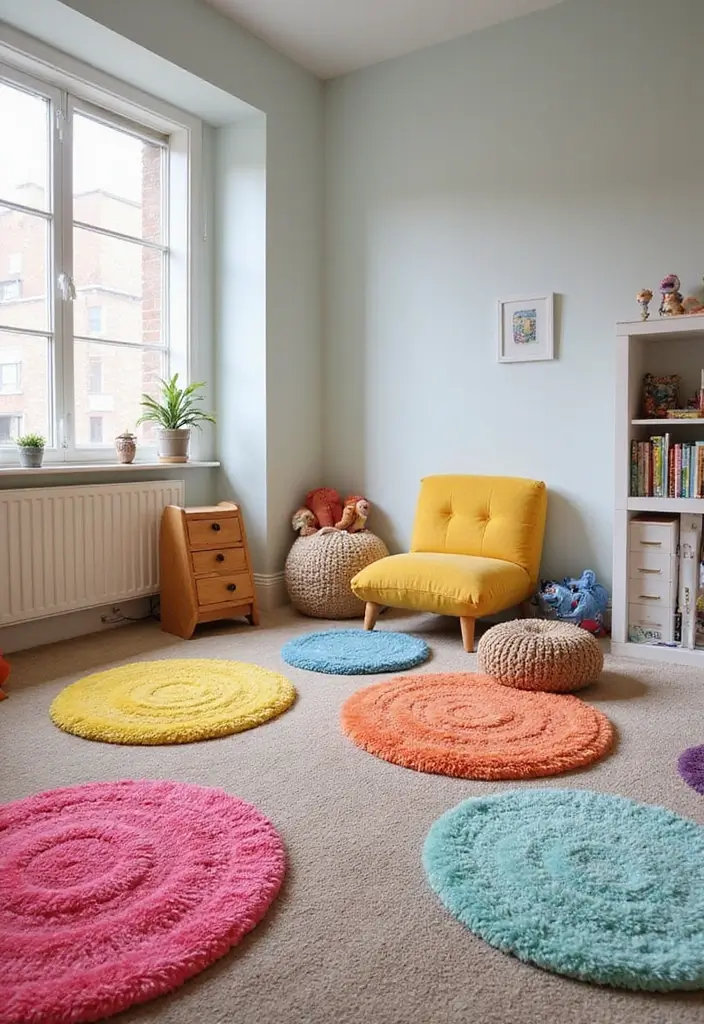
Creating a playful and safe environment for children is vital when layering rugs on carpet. This ensures comfort and safety while adding fun. Here’s how:
– Use bright, colorful rugs that stimulate creativity.
– Opt for materials that are soft and easy to clean.
– Layer them over a plush carpet for added cushioning.
This not only promotes fun but also allows for a cozy play area that’s both stylish and functional.
22. Eco-Friendly Choices
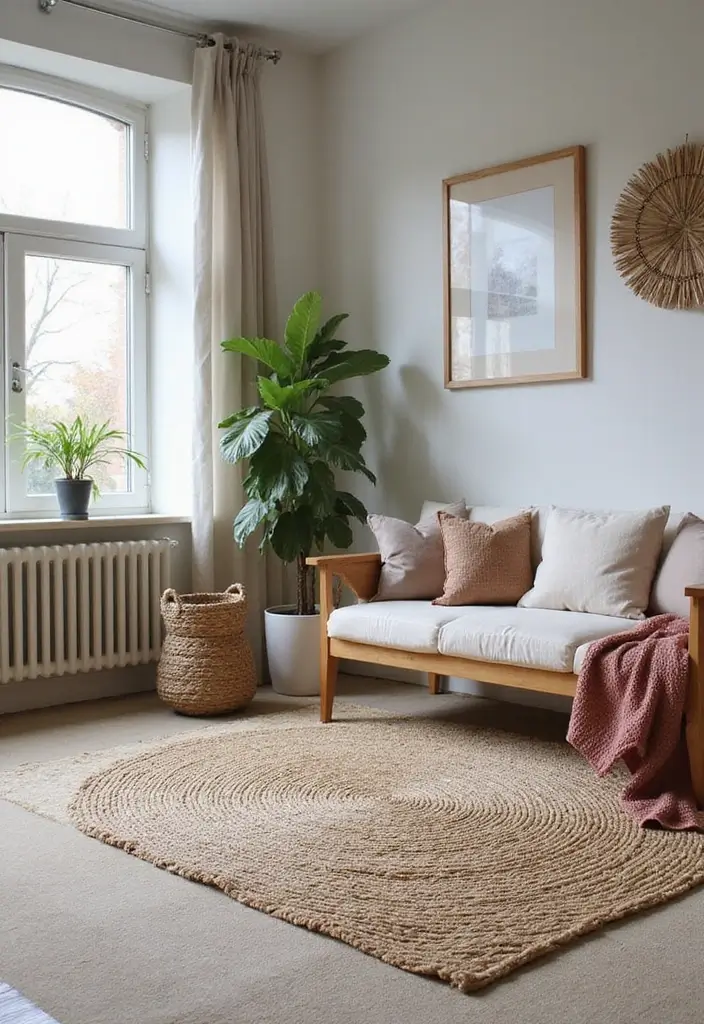
Opting for eco-friendly rugs can enhance your home’s design while being kind to the planet. Layering sustainable rugs on carpet adds both style and conscience. Consider these tips:
– Look for rugs made from recycled materials.
– Pair them with natural fiber carpets for a cohesive look.
– Incorporate plant-based decor elements to highlight your eco-friendly choices.
This approach creates a stylish yet responsible living environment, showcasing your values.
23. Personal Touches
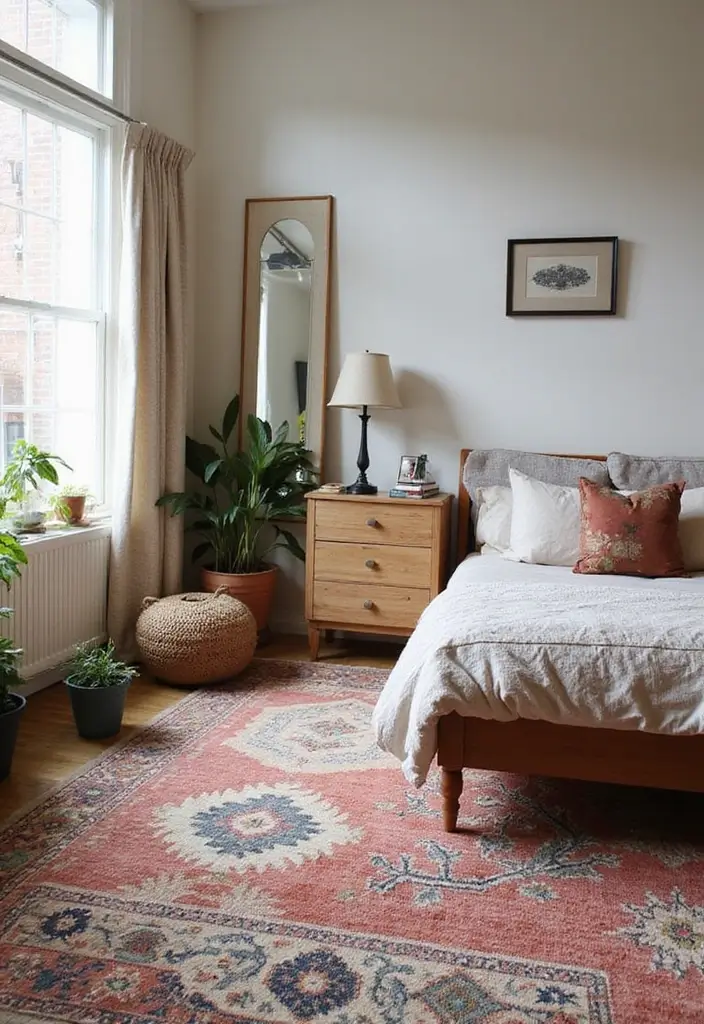
Adding personal touches can make your layered rug arrangements truly unique. Family heirloom rugs or DIY pieces can create a heartfelt environment. Here are some ideas:
– Use rugs that hold personal significance or memories.
– Layer handmade items with newer pieces for a creative mix.
– Incorporate photos or art that reflect your journey.
This approach fosters a cozy and inviting atmosphere that feels distinctly yours.
24. Layering for Functionality
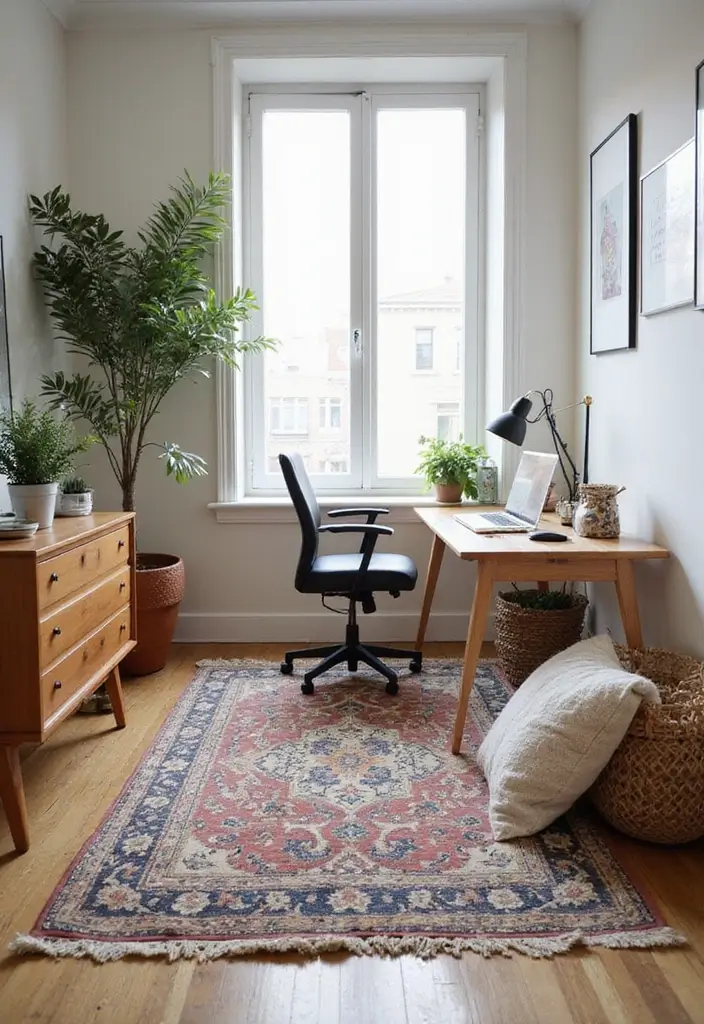
Layering isn’t just about looks—it can enhance functionality too. In areas like home offices or workspaces, a layered rug setup can help define focus areas. Tips for this approach include:
– Use a rug that offers comfort while reducing slippage over the carpet.
– Layer to create distinct work zones within larger spaces.
– Choose colors and patterns that promote productivity.
This enhances both aesthetic appeal and practical utility.
25. The Art of Layering
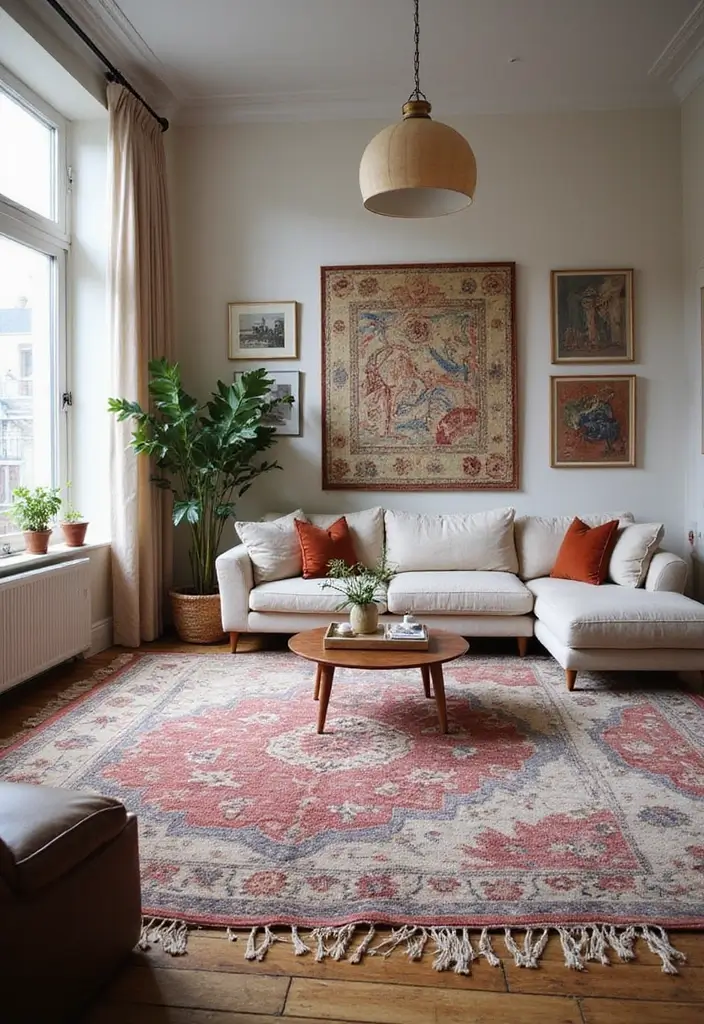
Layering rugs is an art form, and mastering it involves creativity. Mixing different styles and colors can create a dynamic look. Consider these guidelines:
– Layer with a purpose in mind, whether for comfort, style, or functionality.
– Experiment with various shapes and sizes to discover unique combinations.
– Don’t hesitate to showcase unexpected pairings for personal flair.
This encourages a playful and innovative approach to home design.
Layering rugs on top of carpet isn’t just a trend; it’s a canvas for your creativity! Experiment with colors and shapes to transform your space into a cozy masterpiece.
26. The Timeless Classic: Stripes
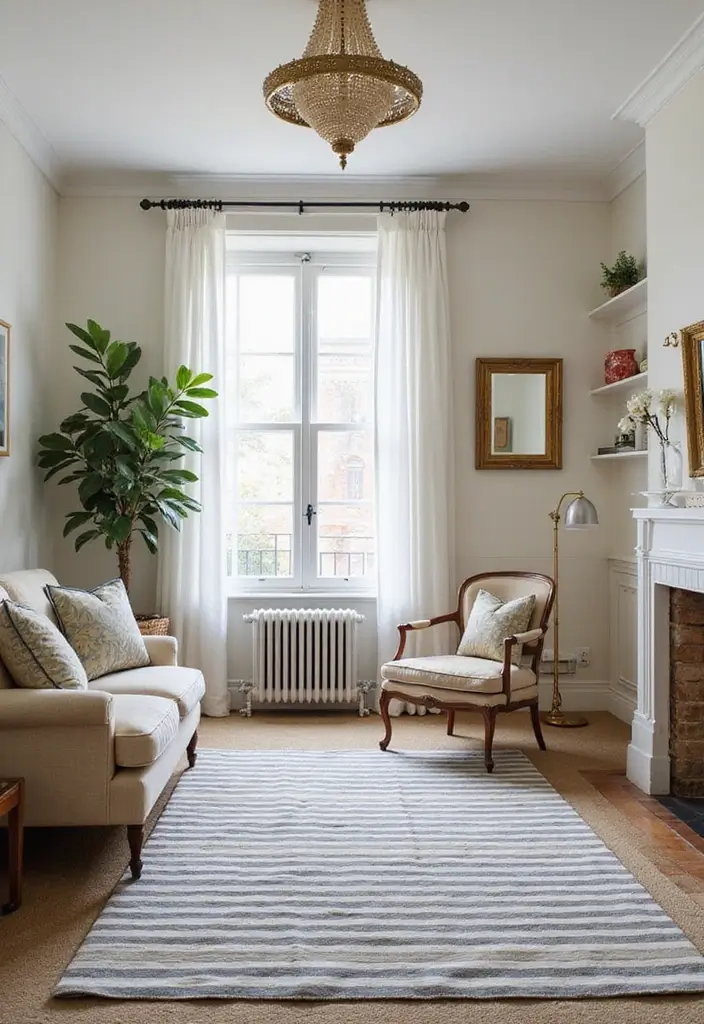
Stripes have an enduring appeal and can be wonderfully layered. When used wisely, striped rugs can add visual interest without overwhelming the space. Here’s how:
– Opt for a bold striped rug on top of a solid carpet to create contrast.
– Use accessories with stripes to match without clashing.
– Remember to keep the stripes in mind while choosing other décor elements to avoid chaos.
This approach maintains timeless elegance and can be adapted to various styles.
27. The Finishing Touch
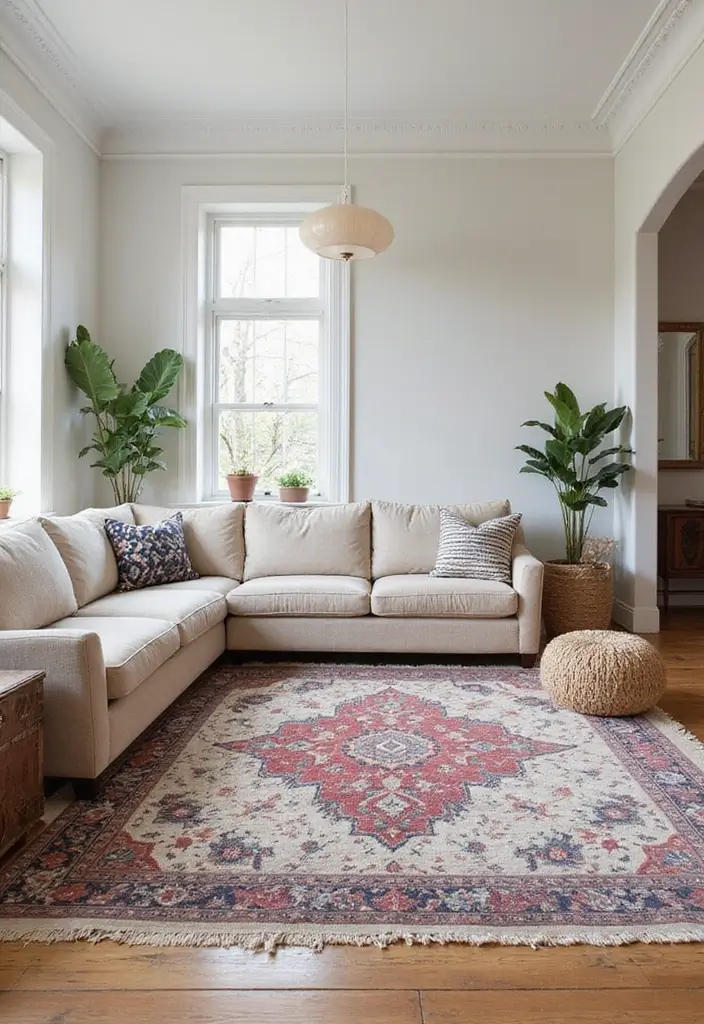
Finally, adding the right finishing touches can elevate your layered rug look. This includes decorative elements that tie the entire design together. Consider these ideas:
– Use ottomans or side tables to accent your layered rugs.
– Incorporate lighting that highlights the texture and colors of the rugs.
– Keep the overall color palette consistent throughout the room.
These finishing touches create a polished and harmonious space that feels complete.
Conclusion
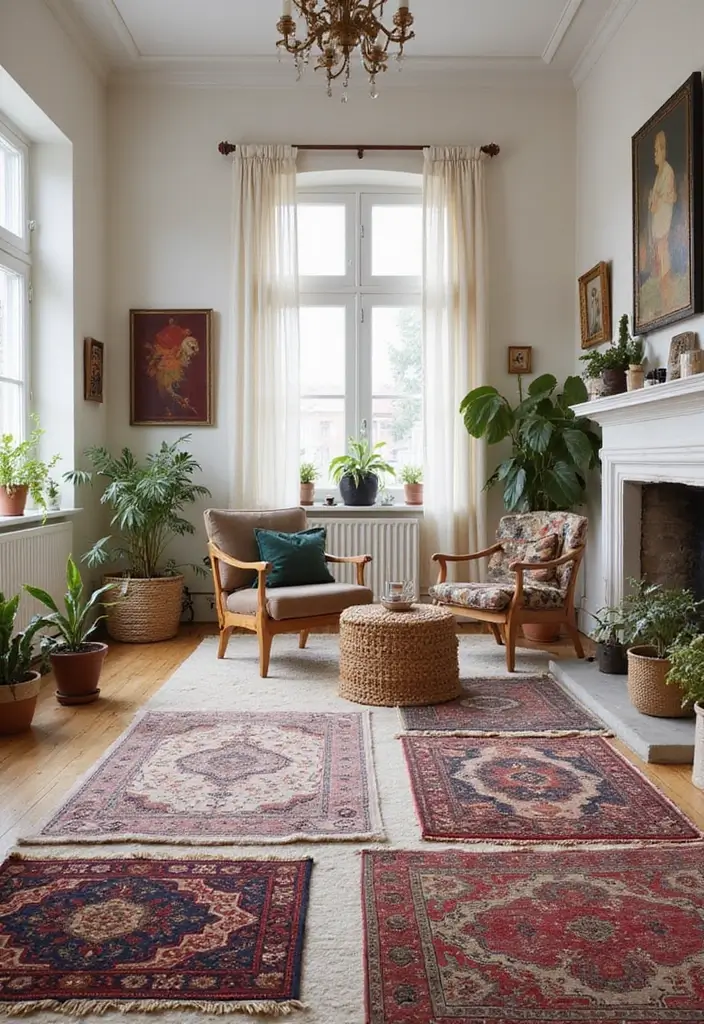
Layering rugs on carpet opens up a world of style and comfort for your home. Each combination can add warmth, texture, and personality, allowing you to express your unique aesthetic.
As you explore these ideas, think about what resonates with your style, and don’t hesitate to experiment with different colors, patterns, and textures. After all, your home should reflect who you are!
Frequently Asked Questions
How Do I Choose the Right Rugs to Layer on Carpet?
Choosing the right rugs to layer on carpet involves considering texture, color, and size. Start by selecting a rug that contrasts well with your carpet color to create visual interest. For instance, a bold, patterned rug can pop against a neutral carpet. Additionally, think about the texture; a soft, plush rug can enhance comfort, while a natural fiber rug can add an earthy touch. Don’t forget to consider size—aim for a rug that fits well within the space and complements your furniture layout!
What Are Some Common Mistakes When Layering Rugs on Carpet?
One common mistake is not considering the scale and proportion of the rugs. Make sure the sizes of your rugs are harmonious with the room dimensions and furniture. Another mistake is overlooking the color palette; ensure the rugs work together and with the carpet to avoid a chaotic look. Lastly, don’t forget to secure your layered rugs to prevent slipping, which can be a safety hazard, especially in high-traffic areas!
Can Layering Rugs on Carpet Help with Noise Reduction?
Absolutely! Layering rugs on carpet can significantly contribute to noise reduction. The additional layer of fabric helps to muffle sound, making your space quieter and more peaceful. This is especially beneficial in homes with hard flooring below the carpet. If you’re looking for a cozy, serene atmosphere, consider using thicker rugs or plush materials that can absorb sound effectively.
How Often Should I Change My Layered Rugs for a Fresh Look?
Changing your layered rugs can breathe new life into your space! Consider switching them out with the seasons or when you feel your decor needs a refresh. For instance, lighter, airy rugs work well in summer, while warmer, thicker rugs are perfect for winter. Additionally, if you notice wear or fading, it’s a good time to explore new options that align with current home decor trends.
What Styles of Rugs Work Best for Layering on Carpet?
When it comes to layering rugs on carpet, styles like geometric patterns, vintage designs, and natural fibers are fantastic choices. Geometric rugs can add a modern touch, while vintage rugs bring character and warmth. Natural fiber rugs, such as jute or sisal, can create a calming effect and balance plush carpets nicely. Always consider your overall interior design ideas to ensure that the layered look feels cohesive and intentional!
Related Topics
home decor
interior design
layering rugs
carpet styling
area rug placement
textured spaces
modern minimalism
vintage charm
eco-friendly decor
bohemian style
cozy living
seasonal decor



